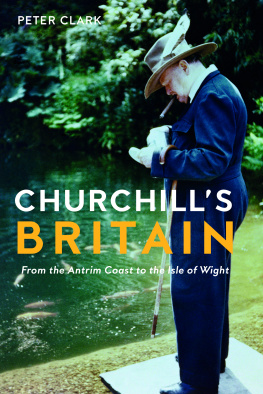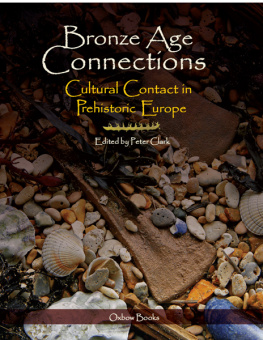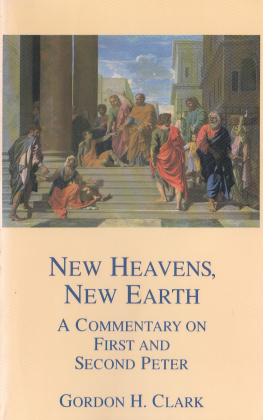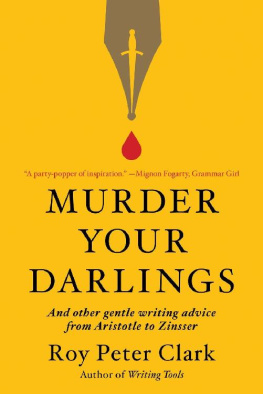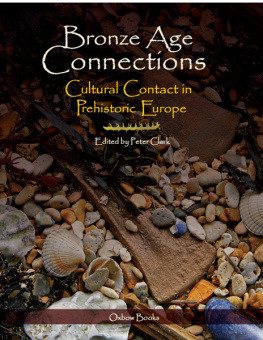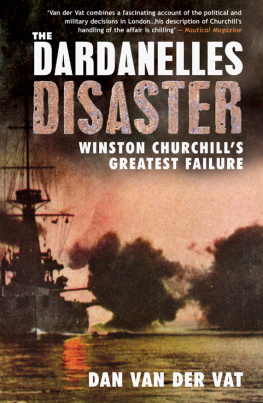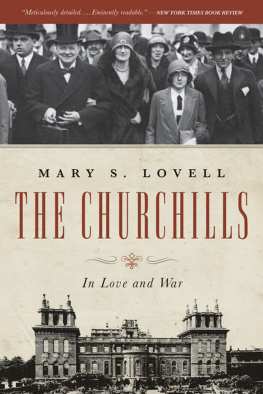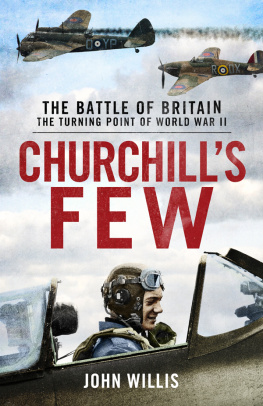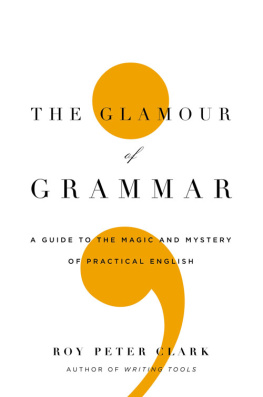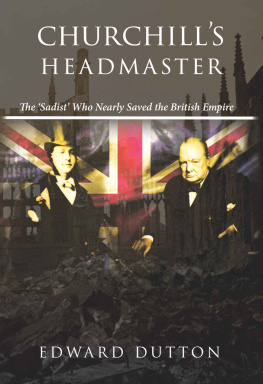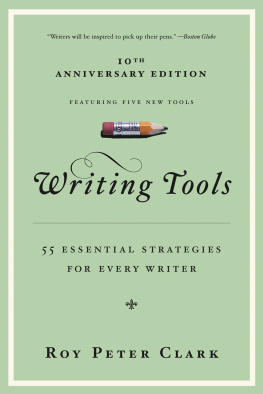Peter Clark - Churchills Britain
Here you can read online Peter Clark - Churchills Britain full text of the book (entire story) in english for free. Download pdf and epub, get meaning, cover and reviews about this ebook. year: 2020, publisher: Haus Publishing, genre: Non-fiction. Description of the work, (preface) as well as reviews are available. Best literature library LitArk.com created for fans of good reading and offers a wide selection of genres:
Romance novel
Science fiction
Adventure
Detective
Science
History
Home and family
Prose
Art
Politics
Computer
Non-fiction
Religion
Business
Children
Humor
Choose a favorite category and find really read worthwhile books. Enjoy immersion in the world of imagination, feel the emotions of the characters or learn something new for yourself, make an fascinating discovery.
- Book:Churchills Britain
- Author:
- Publisher:Haus Publishing
- Genre:
- Year:2020
- Rating:4 / 5
- Favourites:Add to favourites
- Your mark:
- 80
- 1
- 2
- 3
- 4
- 5
Churchills Britain: summary, description and annotation
We offer to read an annotation, description, summary or preface (depends on what the author of the book "Churchills Britain" wrote himself). If you haven't found the necessary information about the book — write in the comments, we will try to find it.
Churchills Britain — read online for free the complete book (whole text) full work
Below is the text of the book, divided by pages. System saving the place of the last page read, allows you to conveniently read the book "Churchills Britain" online for free, without having to search again every time where you left off. Put a bookmark, and you can go to the page where you finished reading at any time.
Font size:
Interval:
Bookmark:



First published in 2020 by
Haus Publishing Ltd
4 Cinnamon Row
London SW11 3TW
Copyright Peter Clark, 2020
Cartography produced by Ml Design
Maps contain Ordnance Survey data Crown copyright and database right 2011
For quotes reproduced from the speeches, works and writings of Winston S. Churchill:
Reproduced with permission of Curtis Brown, London on behalf of
The Estate of Winston S. Churchill.
The Estate of Winston S. Churchill
A CIP catalogue for this book is available from the British library
The moral right of the author has been asserted
ISBN 978-1-909961-74-6
eISBN 978-1-909961-75-3
Typeset in Garamond by MacGuru Ltd
Printed in the United kingdom by Clays ltd (elcograf S.p.a.)
www.hauspublishing.com
For Stella and John
W inston Churchill needs no introduction. No British historical figure has been so abundantly documented. The authorised biography comes to eight volumes over 8,000 pages of text and sits alongside many more companion volumes of relevant papers. Churchill himself wrote six volumes of memoir/history about each of the two world wars. Many volumes of his journalism and speeches have also been published. It is reckoned that a thousand biographies have been penned. Many of his political and military colleagues, his domestic staff and his family have written about him. Every year a significant work of scholarship appears on some aspect of his life, personality or career.
So why add another volume? All my life, I have been interested in places associated with people and events. Specialists and scholars can analyse documents and old newspapers. Anyone can visit a location and allow their imagination to recreate what it was like in the past. Churchill was a great traveller and had fought wars in three continents before he was twenty-five. He was frequently on the move and left records, sometimes even paintings, of the places he visited. My aim in this book is to consider the places in Britain including Ireland before its independence in 1921 that have associations with Churchill. Some are well known, such as Blenheim Palace where he was born and Chartwell which he made his home over his last forty years. The Cabinet Rooms in Whitehall are full of the spirit of Churchill during the years of the Second World War: the only thing missing is the smell of his cigars. I have noted the homes he lived in, his places of study, the offices he occupied and locations where he delivered significant speeches. I have tried to examine the relationship he had with each of the four constituencies he represented in the House of Commons between 1900 and 1964. But there are also many lesser-known locations that tell stories that shed light on Churchills personality or politics.
The book is in the form of a gazetteer, divided into geographical regions. (I have retained the names of counties as they were in Churchills time.) Many of the locations are private homes or working institutions and not open to the public. Privacy must be respected.
The book is restricted to Britain. From childhood to old age, however, Churchill was a frequent visitor to France, which he loved. He travelled extensively, in war and in peace, to the United States and Canada. His travels never took him to China and the Far East, to South America or to Australia and New Zealand, but there are many sites abroad from the North-West Frontier to Cuba, from South Africa to Carthage in Tunisia, from Yalta to Normandy, from Marrakesh to Tehran that could provide material for other books.
Peter Clark
Frome, Somerset, 2020
L ondon was like some huge prehistoric animal, capable of enduring terrible injuries, mangled and bleeding from many wounds, and yet preserving its life and movement.
In 1954, Queen Elizabeth II and Prince Philip, Duke of Edinburgh, were returning from a Commonwealth tour on the Royal Yacht Britannia. Winston Churchill, in his eightieth year, was prime minister and joined the yacht when it was in British territorial waters and together they sailed to London. The queen saw the Thames as a dirty commercial river, but, as she said, Churchill was describing it as the silver thread which runs through the history of Britain.
Churchill had more to do with London than with any other city. He went to secondary school on the outskirts of the capital but, from the beginning of the century, he always had a home in London. Over a third of the locations celebrated in this book are found in London, so I have divided the city into two. First we have the postal area of SWi, which covers the City of Westminster the centre of Britains political life and the socially elite area to the north.
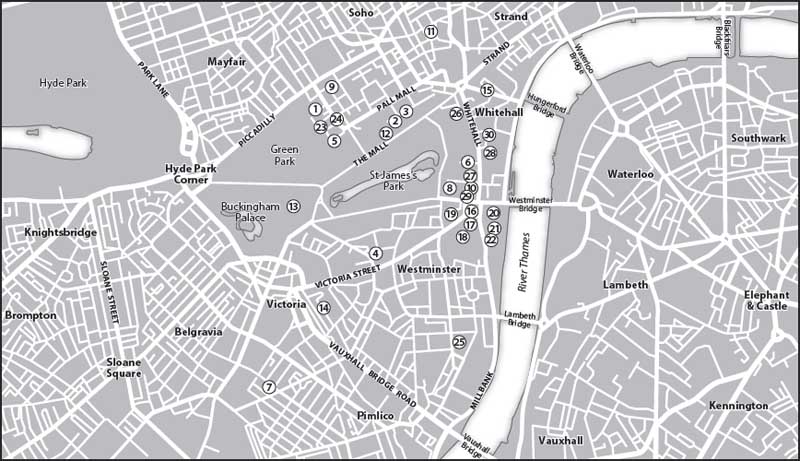
1. Arlington Street, p.6
2. 4 Carlton Gardens, p.6
3. German Embassy, p.7
4. Caxton Hall, p.8
5. Stornoway House, p.9
6. Downing Street
10 Downing Street, p.12
11 Downing Street, p.17
7. 33 Eccleston Square, p.20
8. Cabinet War Rooms, p.21
9. 7172 Jermyn Street, p.28
10. King Charles Street, p.28
11. Empire Theatre, p.29
12. The Mall, p.30
13. Buckingham Palace, p.31
14. Morpeth Mansions, p.32
15. Northumberland Avenue, p.35
16. Parliament Square, p.40
17. St Margarets Church, p.41
18. Westminster Abbey, p.44
19. Methodist Central Hall, P-45
20. Big Ben, p.45
21. House of Commons, p.45
22. Westminster Hall, p.55
23. St Jamess Place and St
Jamess Street
29 St Jamess Place, p.56
6 St Jamess Street, p.57
9 St Jamess Street, p.57
19 St Jamess Street, p.57
24. The Carlton Club, p.59
25. Westminster Gardens, p.59
26. Admiralty House, p.59
27. Foreign Office, p.64
28. Home Office, p.65
29. The Treasury, p.66
30. The Old War Office, p.67
USEFUL ARISTOCRATIC CONNECTIONS
Arlington Street was part of the early development of the fashionable St Jamess quarter of London. It was originally built in the late seventeenth century.
Although there is no plaque, the street featured the London home of the third Marquess of Salisbury, prime minister when Winston Churchill first became a Member of Parliament in 1900. Lord Salisbury was an intellectual, a dabbler in amateur chemistry and, in his earlier days, an essayist dealing with political history. He had just about pushed Churchills father, Lord Randolph, out of the cabinet in 1886, and there was a brittle relationship between the older man and the young Churchill. But Salisbury was generous and took a paternal interest in him. Salisburys son, Lord Hugh Cecil, became a close friend of his, and was best man at his wedding in 1908. While Churchill was still a Conservative until 1904, that is he used to spend time with Lord Hugh Cecil and others who formed an awkward squad known as the Hughligans.
Not far away is Number 21, a house with a forecourt. Formerly known as Wimborne House, it was the principal London home of the family of Viscount Wimborne, Churchills cousin (Wimbornes mother was a sister of Lord Randolph Churchill). Wimbornes son, Ivor Guest successively a Conservative and Liberal MP made Wimborne House available to Churchill and his family after he ceased to be First Lord of the Admiralty in 1915.
Font size:
Interval:
Bookmark:
Similar books «Churchills Britain»
Look at similar books to Churchills Britain. We have selected literature similar in name and meaning in the hope of providing readers with more options to find new, interesting, not yet read works.
Discussion, reviews of the book Churchills Britain and just readers' own opinions. Leave your comments, write what you think about the work, its meaning or the main characters. Specify what exactly you liked and what you didn't like, and why you think so.

